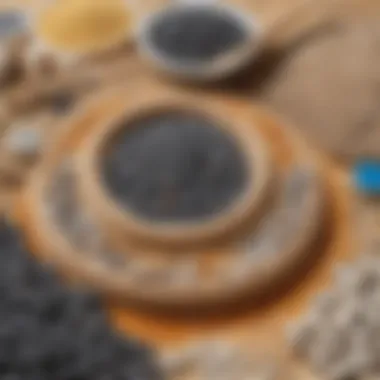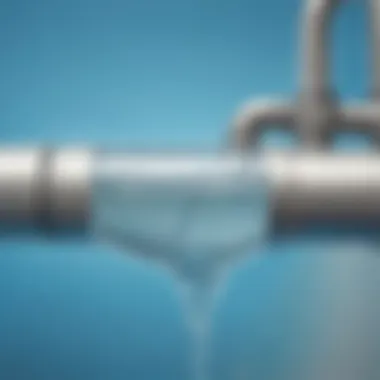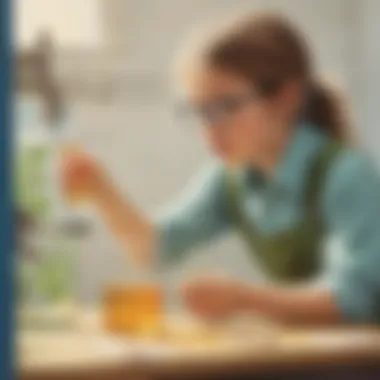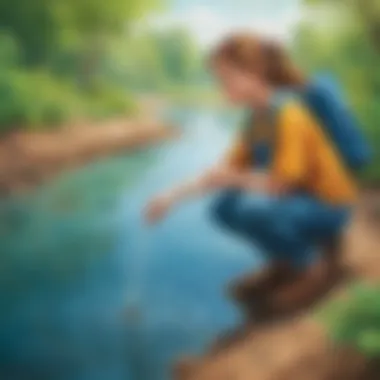Filtering Dirty Water: Engaging Science Experiment


Intro
Water is essential for life. Yet, millions of people around the world still lack access to clean water. Teaching young minds about water filtration is a hands-on way to introduce them to the importance of clean water and the science behind it. This engaging experiment will not only capture their attention but also encourage curiosity about environmental conservation.
Throughout the article, we will dive into several key concepts related to the water filtration process. By following this guide, families will see how they can explore science at home in practical ways. By experimenting with filtering dirty water, children can develop critical thinking skills necessary for their future.
Science Fun Facts
An experiment about cleaning dirty water might sound simple, but it can, in fact, fascinates young learners immensely. Let's explore some fun and interesting science facts!
Interesting Trivia and Facts
- Did you know that about 71% of the Earth’s surface is covered with water? However, only 2.5% is fresh water, and even less is accessible.
- Water filters have been used for centuries. The ancient Greeks also developed methods to filter water using sand.
- Human bodies are composed of about 60% water, making it a vital nutrient for our survival.
Quirky Science Stories
In 1977, scientists launched the Voyager spacecraft carrying records of sounds from Earth. Among the things included were the sounds of rain, waves, and even children laughing. This signifies how interconnected water is to life on our planet.
Amazing Science Records
The most well-known water filtration method is perhaps the sand and gravel filter used for drinking water standards. Engineering marvels, like the large-scale filtration systems in places like New York City, help provide millions of people with quality water.
Prolusion to Water Filtration
Water filtration is a fundamental need in our world. Understanding it is crucial, especially for young minds who are starting to explore scientific concepts. This section dives into water filtration, specifying its core principles and the undeniable importance of securing clean water.
Understanding Filtration
Filtration is the process of removing particles and impurities from liquids using a barrier or filter. This method often relies on physical means, such as mesh or sandy layers. Young learners can set up a simple filtration system just using materials they find at home. By doing this experiment, they grasp how different structures capture unwanted materials. Moreover, the fascinating alloy of science and everyday life will become apparent. They can observe how the sludge in dirty water can be transformed into something clear and potentially drinkable.
There are various levels of filtration, beginning with the most basic, such as using coffee filters or cotton. Higher levels include complex systems used in large municipalities to purify water for entire communities. Children have the opportunity to experience this foundational science directly. This anecdote helps make theoretical knowledge practical and applicable.
Importance of Clean Water
Every person requires clean water for survival, health, and comfort. Receiving safe drinking water is a global priority. Children should understand how critical it is to avoid waterborne diseases and pollution. Addressing this topic is not only informative but essential for developing their sense of responsibility toward the environment.
Organizing an experiment about water filtration allows children to empathize with many around the world who lack access to clean, safe water. Goals such as the United Nations Sustainable Development Goals clearly outline that clean water is a basic human right. This understanding helps children not just be aware of these issues but motivates them to consider solutions.
“Water is the driving force of all nature.” — Leonardo da Vinci
Discussing the importance of clean water readies students for a more significant social discussion later in life. Statistical knowledge surrounding global water accessibility becomes a window into wider educational pursuits and potential scientific endeavors. Through such insightful examination, learners can become advocates for change and empower themselves to take proactive actions in their immediate surroundings.
Scientific Principles Behind Filtration
Understanding how filtration translates to practical applications is key. Filtration is not just a concept; it's a daily necessity that influences our health and well-being. This article invites young minds to explore the intricacies of filtration, which can spark curiosity and foster environmental awareness.
How Filtration Works


Filtration is based on a straightforward principle. It separates impurities from a liquid by either physical or chemical means. The small particles causing turbidity are trapped, while cleaner water passes through.
Here is a basic outline of the process:
- First, you pour dirty water through a barrier made from a different material.
- Next, larger particles cannot pass this barrier and get stuck.
- Finally, the purified water collects below, showcasing what happens when an effective filtration system is at work.
Of course, the effectiveness of any filtration method depends on its setup and the materials used. Basic setups rely on standard materials, making it accessible for educational environments. Children can relate to this by thinking of a coffee filter trapping grounds while allowing water to seep through.
Different Filtration Methods
Filtration methods vary according to materials and desired results. Here are several popular methods:
- Mechanical Filtration: Utilizes barriers to physically separate impurities from water. A popular example includes the use of sand in a sand filter where the top layer traps larger particles while allowing smaller toxins to flow through.
- Chemical Filtration: Involves adding chemicals to remove impurities. Activated carbon filters can absorb contaminants, improving water taste and odor.
- Biological Filtration: Uses living organisms, like microalgae, to absorb pollutants from water. This method is all about relying on natural processes for cleaning water.
Understanding all these various filtration methods gives insight into their benefits and limitations.
“Knowing how different water filtration systems work raises awareness among children and helps them appreciate the necessity of clean water.”
It is crucial for both young learners and their instructors to grasp these principles. As students engage in this experiment, they tap into science that they can appreciate in practical situations and day-to-day life.
Materials Needed for the Experiment
Gathering the right materials is a crucial step when conducting any science experiment. This concept also applies to filtering dirty water. The materials will determine not only the effectiveness of the experiment but also ensure safety for all participants. Knowing what to use, where to source these items, and how they contribute to the filtration process enables a structured and meaningful learning experience.
Obtaining materials from common household sources can enhance engagement. Kids often find a certain joy in recognizing familiar items being used in an experimental setting. Several materials on hand can kickstart this process. Furthermore, learning about the insights behind each item cultivates richer understanding and appreciation among young minds. It creates connections between their everyday life and broader scientific concepts.
Common Household Items
In preparing for this experiment, you may not need to break the bank. Instead, utilize materials commonly found in your home. Here are some key items that are essential:
- A clear plastic bottle: It can serve as your filtration container.
- Sand: A common material, it plays a key role in filtering out larger particles.
- Coffee filter or cheesecloth: This aids in removing fine sediments effectively.
- Activated charcoal: This component helps to eliminate contaminants and further purify the water.
- Gravel: This can act as a first line for sediment accumulation.
By collecting these items, participants can visually follow the filtration process of dirty water. It draws a direct line from scientific theory to observable practice, which is a critical learning point in any science experiment.
Safety Precautions
Running experiments, even simple ones at home, should be performed with safety firmly in mind. While the materials may seem benign, there are still considerations to manage their use safely. For water filtration, ensuring careful strategies can prevent mishaps and foster a responsible attitude towards handling materials. Consider these important precautions:
- Work in an appropriate area: Choose a space that can get wet or dirty without worry. An outdoor area or a kitchen counter protected with newspaper works well.
- Wear gloves: This can help in preventing contact with possible dirty or harmful substances in the water or when handling materials.
- Adult supervision: Younger children should have adults nearby to guide the experimentation process securely.
- Handle water responsibly: Make sure children understand basic rules about not ingesting contaminated water. This reinforces critical lessons about health and safety.
Maintaining safety during science experiments goes a long way in promoting trust in scientific inquiry.
Utilizing these safety measures minimizes risks and promotes an environment conducive to learning. This balanced approach allows for engaging experimentation without compromising the health and wellbeing of participants. Nurturing curiosity in a secure atmosphere makes the learning experience enjoyable yet responsible.
Step-by-Step Instructions
The section of step-by-step instructions is essential in guiding readers through the practical aspects of the experiment. This framework promotes understanding for young learners. Each step contains vital details about how to effectively perform the filtration process. Furthermore, clear instruction minimizes confusion and increases the likelihood of success in filtering the water. It allows children and their caregivers to follow along easily while nurturing critical thinking and scientific inquiry.


Preparing the Dirty Water
In this step, this involves creating dirty water to filter, which is a crucial part of the experiment. Gather clean water and combine it with various substances to simulate polluted water. Consider including items like soil, small food particles, or mud. It is important to allow the young learners to experiment with different types and quantities of dirt. This gives practical perspective on what might end up in real water sources. Explain how contaminants affect water quality while they mix these materials. Keeping it hands-on helps them visualize the problem.
Setting Up the Filtration System
Next, sizing up the filtration system is critical for ensuring the experiment runs smoothly. Begin by selecting materials for filtration, like coffee filters, sand, and gravel. Instruct young learners to layer these items in a funnel or a plastic cup. This setup mimics actual water treatment systems. Highlight the importance of each layer—how larger particles might get trapped in gravel while smaller particles reach the coffee filter. This part shows learners mechanical principles behind filtration. Confirming the construction of the filtration device is sturdy enhances safety and effectiveness.
Conducting the Experiment
Now, the experiment proceeds to conducting the filtration process. Carefully pour the dirty water into the prepared filtration system. It is essential to do this slowly enough to avoid spills but quick enough to maintain interest. Observe as the water moves through the layers. Encourage learners to note how the appearance of water changes as it passes. Remind participants of what was added at the initial step, and bring mentions of why these contaminants matter. Laboring through this process teaches them patience and reinforces understanding of flow dynamics.
Observing Results
Finally, observing results is an enlightening and engaging end to the experiment. Have the young scientists closely examine the filtered water collecting below. Ask questions such as: How does it look in comparison to the dirty water? If a comparison can be made, identify the visible differences. This part encourages analytical thinking. Record results, and share insights; as documentation inherently nurtures science communication. Encourage them to reflect on this experience and how these principles might influence real-world water issues. This fosters a commitment to and understanding of healthy water sources.
Analyzing Experiment Outcomes
Understanding the results of any scientific experiment is crucial, especially in a water filtration project. Here, analyzing the outcomes helps participants see connections between their expectations and actual results. Children learn about accuracy, compare effects of various materials, and build a foundation in data analysis.
When kids discover whether their filtration effectively removed dirt and impurities, it deepens their understanding of the science behind the process. It also encourages more thoughtful inquiries regarding how to make improvements in future experiments.
Data Recording
Data recording is an essential step in scientific inquiry. It teaches children to document observations systematically. Accurate entries generate reliable data, which is beneficial for examining how filters performed. Here's how to set this up:
- Organized Logs: Different types of filtration devices should be logged separately in a notebook. Children should note their initial observations of both the dirty and the filtered water. Include how dirty the water looked before and after.
- Descriptive Notes: Describe the materials used to filter along with why these materials were chosen. Has any material worked better than others? This comparison encourages critical thinking and nuanced discussions about choice.
- Photographic Evidence: Taking pictures of each stage can help visualize the scale of results. Kids can create a timeline of filtering progress.
Overall, by encouraging young scientists to meticulously record their data, we bolster their analytical skills and enhance their investment in understanding the scientific method.
Interpreting Results
Interpreting results from the filtration experiment involves more than just observing the outcome. It allows children to connect theoretical concepts with real-world scenarios. They can rationalize why certain filtration methods succeeded while others may have fallen short. Here are important components for interpretation:
- Analysis of Visuals: Kids can start by comparing before-and-after photos. Evaluating physical changes in color and clarity sparks meaningful dialogue.
- Quantitative Assessment: When feasible, have children measure things like the degree of turbidity. They can convert visual observations into measurable data and improve their understanding of how scientific analysis works.
- Discussion and Reflection: A group discussion among young scientists about their findings allows them to express their thought process. Commentary on discrepancies between expectations and outcomes is essential. Whatever the conclusion, analyzing results develops broader insights about filtration technology's effectiveness in various contexts.
As they explore filtration methods and their real-world application, the children gain valuable knowledge, reinforcing both their practical and theoretical understanding of clean water importance. All these factors create a rich tapestry of inquiry, further igniting curiosity and developing comfort within scientific frameworks.
Real-World Applications of Filtration
Understanding how filtration works is increasingly relevant in real life's practical applications. By implementing methods learned from simple experiments, children can grasp an important concept that has significant uses in the world today.
Water Purification Systems
Water purification systems incorporate different methods to clean and treat water before it reaches homes and industries. These systems can vary in design but focus on the same goal—to make water safe for drinking and use.
Examples of common water purification systems include:


- Reverse Osmosis Systems: These systems use pressure to push water through a semi-permeable membrane, allowing clean water to pass while unwanted impurities are blocked.
- UV Treatment: Ultra-Violet light can inactivate harmful microorganisms in water, making it safe to consume, without the need for chemicals.
- Carbon Filters: Usually found in household water pitcher filters, activated carbon effectively removes chlorine and other impurities through adsorption.
Children can learn how domestic water treatment feels like. By experimenting with basic filtration techniques at home, they understand how these sophisticated systems work in a simplified way, making the learning experience more vivid.
Environmental Impact
The environmental impact of water filters is a crucial aspect that often goes unnoticed. Use of proper filtration reduces pollution and helps conserve vital natural resources. There are a few main points worth mentioning:
- Reduced Pollutants: Proper filtration leads to cleaner water bodies, thus minimizing the release of harmful levels of chemicals and toxins into lakes and rivers.
- Conservation of Water: Efficient filtration systems drive overall efficiency, allowing for water recycling and recovery methods.
- Protection of Ecosystems: Clean water contributes to healthier ecosystems, ensuring the survival of many aquatic species.
Investing in better filtration systems can help mitigate much of the global water crisis, proving how scientific advancements translate to real-life solutions.
By pondering upon these real-world applications, young learners not only advance their understanding of filtration but also recognize its direct implications for personal health and the environment.
Encouraging Further Exploration
Encouraging further exploration in the field of water filtration is essential for young minds. This article guides children and caregivers through a science experiment, but the prompt for inquiry should not end there. Making connections to broader scientific principles expands understanding and fosters curiosity. By delving deeper into the topic of water filtration, children can appreciate various related subjects.
Additional Experiments
Once the initial experiment is complete, children can engage in additional experiments to broaden their knowledge. These could include:
- Testing Different Filter Media: Explore materials like sand, gravel, or activated charcoal. Test how each affects water clarity.
- Creating Multi-Stage Filtration Systems: Combine various materials for a more complex filtration system to observe differences in effectiveness.
- Investigating Contaminants: Introduce various contaminants such as dirt, sugar, or oil to see how they affect the filtration process.
These experiments not only build skills in using the scientific method but also provide opportunities for creativity while exploring the importance of clean water.
Using Technology in Experiments
In today's world, technology should play a key role in scientific exploration. There are many techniques and tools available to assist children in their studies of water filtration. For instance:
- Video Documentation: Encourage children to create videos of their experiments. This allows them to reflect on the process and results.
- Data Analysis Software: Use simple programs or apps to analyze the data collected from their experiments, making learning interactive.
- Online Communities: Engage with science forums, such as Reddit, where learners can share their findings or get advice globally.
Integrating technology not only assists in making the experiments more engaging but also helps in developing digital literacy, which is essential in modern education.
Exploring water filtration and benefiting from practical experiments provide foundational experience. This solidifies the recognition of clean water as a vital resource in our world.
Through systematic exploration and creativity, familiarizing young learners with the significance of water will instill an appreciation for science and concern for environmental conservation.
Ending
The Importance of Scientific Inquiry
Scientific inquiry is essential in understanding the world around us. It involves asking questions, making observations, and testing hypotheses. In this article, we highlighted the journey children can embark on through the water filtration experiment. Engaging in such an exploration allows young minds to grasp fundamental concepts like filtration and the significance of clean water. The hands-on nature of the experiment fosters curiosity and encourages students to become active participants in their learning. When confronted with scientific challenges, children not only acquire knowledge but also develop problem-solving skills and critical thinking.
Furthermore, engaging children in scientific inquiry can nurture their intrinsic interest in science. They learn how to approach challenges methodically, forming the basis for understanding more complex scientific topics in the future. Ingraining a love for scientific processes at a young age can result in lifelong learners, who may contribute to scientific advancements down the line.
"Scientific inquiry promotes critical thinking skills essential for lifelong learning."
Commitment to Clean Water
Clean water is vital for humanity. This article emphasizes the responsibility we have regarding water conservation and filtration. Teaching children about the importance of clean water goes beyond just words; it requires action. Conducting the water filtration experiment not only demonstrates how filtering works but also lays the groundwork for future environmental stewardship.
Communicating the significance of clean water means recognizing its role in health, sustainability, and community well-being. Children learn early that every effort, no matter how small, can make a difference. Illustrating the process of water treatment empowers them to see the correlation between scientific practices and real-world applications. When children understand the connection between science and their environment, it prepares them to advocate for and take steps toward preserving our natural resources.
Lastly, the commitment to clean water instills values of respect towards nature, driving home the importance of conserving this crucial resource for future generations. This awareness nurtures responsibility and engages young minds in discussing graduated solutions to global water challenges.







